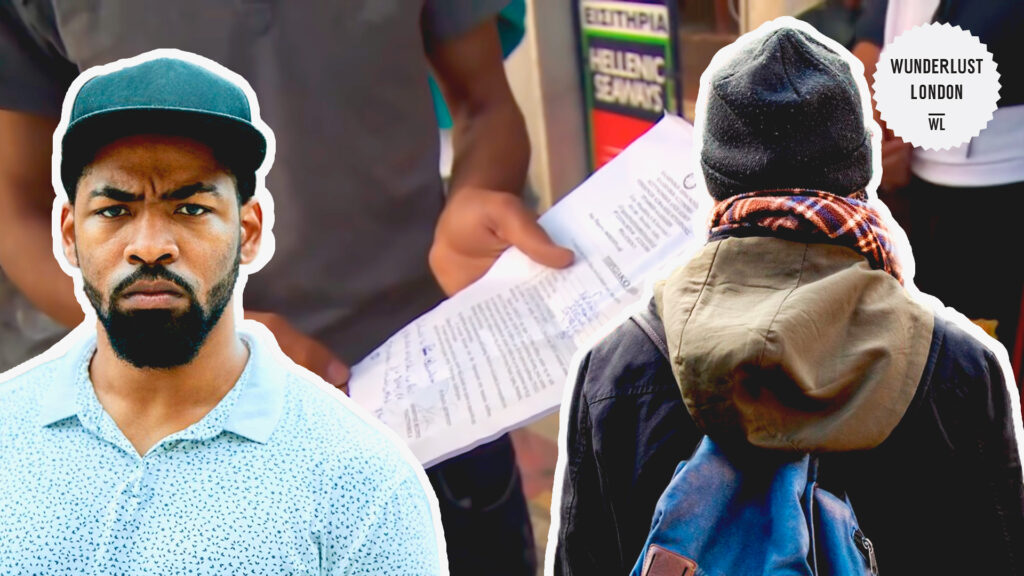If dire circumstances have you pondering a future filled with English breakfasts and slightly damp weather, then you’ve stumbled upon the right place.
Claiming asylum in the UK ain’t no walk in the park (mostly because of the rain), but with our guide, you’ll be navigating the red tape with a stiff upper lip and a cuppa in hand. It might not always be sunny, but we’ll help you find your way.
How to claim asylum in the UK?

| Difficulty | Moderate ●●●○○ |
| Time needed | Varies, but often takes several months |
| Things you need | Proof of identity and journey to the UK, detailed reasons for seeking asylum, completed application forms, and biometric data (fingerprints and photograph) |
To claim asylum in the UK, you need to know your eligibility, arrive in the UK, do a screening and substantive asylum interview, and then wait for a decision. You can appeal if your claim is denied.
Let’s go into detail for each step below.
Step 1. Know your eligibility

Before you start the application, you need to understand the reasons why the UK grants asylum.
Specifically, the UK grants asylum to those with a well-founded fear of persecution based on
- Race
- Religion
- Nationality
- Political opinion
- Membership in a particular social group (think LGBTQ+ community)
But this fear of persecution must be so severe that you can’t live safely anywhere in your home country. You can also check out The UK government’s handy guide for more resources.
Step 2. Arrive in the UK

While it might seem obvious, you can’t claim asylum from your home country or a neighbouring one. You must physically arrive in the UK for your application to be considered.
Arriving in the UK triggers the official process where they assess whether you qualify for refugee status. It also allows you to gather evidence to support your claim, like witness testimonies or documents showcasing the dangers you faced at home.
To officially start your claim once you’re in the UK, inform a border official immediately if you arrive at a port of entry (like an airport). But If you’re already in the country, make sure to contact the Home Office or visit an Asylum Intake Unit to schedule your initial screening interview.
Step 3. Screening interview

The screening interview is where you begin to tell your story and the UK authorities gather information to understand your situation.
They’ll confirm your identity through security checks and ask questions about your background, travel, and any safety concerns – this helps them provide appropriate support.
The interview usually lasts 30 minutes to two hours, but complex cases might take longer. Remember, this is your chance to request “Asylum Support” for accommodation and financial assistance.
While the interview might feel stressful, it’s your first opportunity to explain why you need protection. Be honest, detailed, and clear. You can also seek guidance from free legal aid organisations specialising in asylum cases, though your lawyer won’t be present at the interview.
Step 4. Substantive asylum interview

The substantive interview is your chance to explain why you seek protection and show evidence that supports your claim. Over about 2 hours, you can tell the interviewer about your experiences – this helps them understand the danger you faced and why you can’t return home.
Unfortunately, it may take a long time to get this interview scheduled. The Home Office has a huge backlog of cases (more than 175,000 asylum decisions), so delays are common. This is frustrating, but not your fault! While you wait, you can practise telling your story to others.
Step 5. Get your asylum decision

The long and often stressful wait for your UK asylum decision finally reaches a critical point. This decision will determine if you can build a safe and secure life in the UK. It’s a big deal, and it can lead to several potential outcomes.
You might be officially recognised as a refugee, in need of the UK’s protection. Or, you could receive humanitarian protection, which means you can’t return home due to safety concerns.
Both of these options will allow you to stay in the UK for at least 5 years, and potentially apply for permanent residency later (along with any dependents).
However, if your claim was not accepted, you’ll need to proceed to our next step.
Step 6. Make an appeal (if necessary)

Facing a rejected asylum claim can be disheartening, but don’t despair. You have the right to appeal the decision. This lets you challenge potential errors, present new evidence, or seek a fresh review from a different tribunal.
Your first appeal goes to the First-tier Tribunal, and you might be able to file a fresh claim with new evidence or changes in UK asylum law. Just make sure to act fast – you usually have just 14 days after the rejection to file the appeal.
An IAFT-5 form outlines your reasons and can be submitted online or on paper. The judge’s decision usually comes in writing within a week. However, if your appeal gets rejected, you can still make further appeals to the Upper Tribunal, although this may be more complex and costly.







